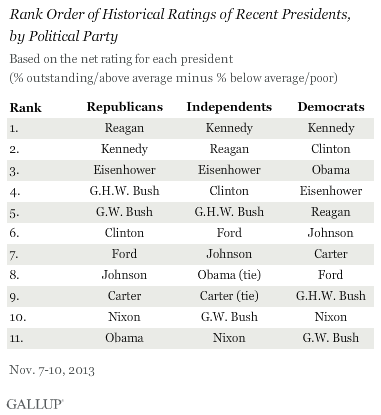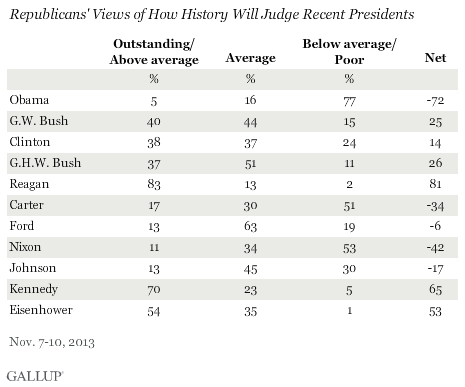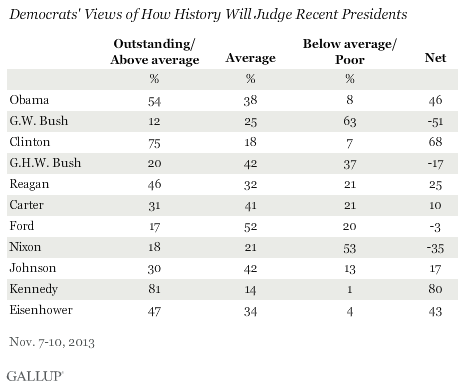PRINCETON, NJ -- In assessing the legacies of the last 11 U.S. presidents, Republicans and Democrats diverge most in how history will judge Presidents Barack Obama and George W. Bush. Republicans believe Obama will be judged worst among recent presidents, while Democrats predict Bush will. At the same time, Republicans expect Bush to get a favorable historical review, and Democrats anticipate the same for Obama.

The results are based on a Nov. 7-10 Gallup poll. Overall, Americans judge John F. Kennedy most positively among recent presidents, followed by Ronald Reagan and Bill Clinton. Richard Nixon is rated worst. Americans on balance expect Bush and Obama to be rated negatively, with overall net scores of -22 and -12, respectively.
In addition to the politically polarized views of Obama and Bush, there are also large partisan gaps in ratings of Clinton and Reagan. However, Democrats and Republicans at least agree that Clinton and Reagan will be judged positively; they differ in the extent of the positive ratings.
Americans' highly polarized views of those four presidents are consistent with previous Gallup research showing they had the most polarized job approval ratings while president.
Republicans' and Democrats' ratings are most similar for Gerald Ford. The net rating for Ford, based on the difference in the percentage rating him an outstanding or above-average president and the percentage rating him below average or poor, is -6 for Republicans and -3 for Democrats.
The party gaps in ratings are also relatively small for Nixon, Dwight Eisenhower, and Kennedy.
For full ratings of each president by party, see page 2.
Democrats, Republicans Agree on Positive or Negative Review for Six Presidents
Of the 11 presidents since Eisenhower, Democrats and Republicans broadly agree on six. Both groups predict history will judge four presidents mostly positively (Kennedy, Eisenhower, Reagan, and Clinton) and two mostly negatively (Nixon and Ford).
Partisans disagree on whether history will judge the remaining five presidents positively or negatively. Consistent with each president's political affiliation, Republicans believe history will judge the older and the younger George Bush positively, and Democrats think Obama, Jimmy Carter, and Lyndon Johnson will get favorable reviews.
Kennedy Ranks Near Top, Nixon Near Bottom, for All Party Groups
Naturally, the party differences in ratings of presidents produce discrepancies in the relative rank-order of each president by party. However, there are some similarities in how Republicans, Democrats, and independents rank each president on a relative basis.
For example, Democrats and independents rank Kennedy first, and Republicans rank him second to Reagan. Eisenhower ranks third or fourth among each party group.
All three party groups rank Nixon near the bottom. He is the most negatively rated president among independents, and second-most negatively among Republicans (after Obama) and Democrats (after George W. Bush).

The widest divergences in rank order are, not surprisingly, for Obama -- ranked third by Democrats and 11th by Republicans -- and George W. Bush, ranked fifth by Republicans and 11th by Democrats. Independents rank both Bush and Obama near the bottom.
Implications
Of the 11 recent presidents, a majority of Americans overall expect three -- Kennedy, Reagan, and Clinton -- to go down in history as outstanding or above average, with Eisenhower the only other to be rated more positively than negatively.
Americans give net-negative ratings to each of the remaining seven presidents. Many of these presidents, especially the more recent ones, operated in a time of highly politically polarized views of their performance, which helps explain the incredibly divergent ratings of the current president.
It is possible that the party differences in ratings of Obama will moderate somewhat after he leaves office. Just prior to George W. Bush's departure, there was a 95-percentage-point difference in Republicans' and Democrats' net ratings of him, compared with the current 76-point difference. Similarly, the 77-point difference by party in net ratings of Clinton just before he left office has shrunk to 54 points. That has had the effect of improving both Bush's and Clinton's overall ratings compared with what they were while the two men were in office.
Certainly, much history remains to be written for Obama's presidency. Gallup conducted the most recent poll at a time when he has near-record-low approval ratings, and has been faced with significant challenges, including problems with the major rollout of the 2010 Affordable Care Act, a government shutdown, the need to raise the federal debt limit, and Syrian chemical weapons attacks. As a result, his own historical rating has grown more negative since the last time Gallup measured it, in February 2012. The actions Obama takes as president over the remaining three years in his term will determine whether Americans evaluate his legacy more positively or more negatively.
Survey Methods
Results for this Gallup poll are based on telephone interviews conducted Nov. 7-10, 2013, with a random sample of 1,039 adults, aged 18 and older, living in all 50 U.S. states and the District of Columbia.
For results based on the total sample of national adults, one can say with 95% confidence that the margin of sampling error is ±4 percentage points.
For results based on the total sample of 272 Republicans, one can say with 95% confidence that the margin of sampling error is ±8 percentage points.
For results based on the total sample of 292 Democrats, one can say with 95% confidence that the margin of sampling error is ±7 percentage points.
Interviews are conducted with respondents on landline telephones and cellular phones, with interviews conducted in Spanish for respondents who are primarily Spanish-speaking. Each sample of national adults includes a minimum quota of 50% cellphone respondents and 50% landline respondents, with additional minimum quotas by region. Landline and cell telephone numbers are selected using random-digit-dial methods. Landline respondents are chosen at random within each household on the basis of which member had the most recent birthday.
Samples are weighted to correct for unequal selection probability, nonresponse, and double coverage of landline and cell users in the two sampling frames. They are also weighted to match the national demographics of gender, age, race, Hispanic ethnicity, education, region, population density, and phone status (cellphone only/landline only/both, and cellphone mostly). Demographic weighting targets are based on the March 2012 Current Population Survey figures for the aged 18 and older U.S. population. Phone status targets are based on the July-December 2011 National Health Interview Survey. Population density targets are based on the 2010 census. All reported margins of sampling error include the computed design effects for weighting.
In addition to sampling error, question wording and practical difficulties in conducting surveys can introduce error or bias into the findings of public opinion polls.
For more details on Gallup's polling methodology, visit www.gallup.com.



